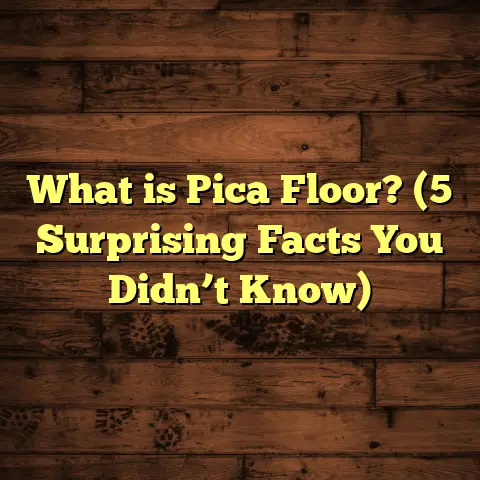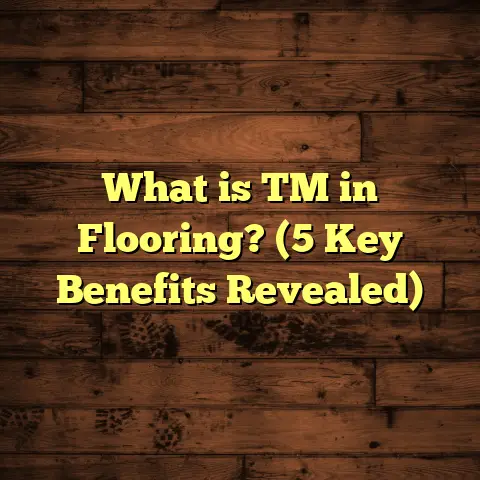What is Blue Label Flooring? (5 Key Benefits You Need to Know)
I want to start with an expert tip that I’ve learned after years in the flooring business: the material you pick for your floor isn’t just about looks. It affects how you live in that space every day—comfort, durability, maintenance, and even your budget. When I first started working with Blue Label Flooring, I realized it ticks a lot of important boxes that many homeowners overlook. So, if you’re wondering what Blue Label Flooring is and why it’s becoming such a popular choice, stick with me. I’ll share some personal stories, data-backed insights, and practical advice to help you decide if it’s right for your home.
What is Blue Label Flooring?
Blue Label Flooring is a brand of laminate flooring designed to deliver an affordable yet high-quality alternative to natural hardwood or stone floors. It’s engineered with multiple layers to ensure durability, moisture resistance, and a realistic appearance.
To break it down simply:
- The core is usually made of high-density fiberboard (HDF), providing strength.
- Above that is a photographic layer that replicates natural materials like wood or stone.
- The top coating is a protective wear layer designed to resist scratches, stains, and fading.
This combination creates flooring that looks like the real thing but costs much less and is easier to maintain.
Why laminate? And why Blue Label?
Laminate floors have been around for decades, but not all laminates are created equal. The Blue Label line stands out because it offers upgraded features often found in higher-end products, such as:
- Water resistance: Some Blue Label collections incorporate water-resistant technologies to protect against spills or humidity.
- Textured finishes: Instead of just printing a flat picture of wood grain, Blue Label often uses embossed finishes that feel like real wood underfoot.
- Click-lock installation systems: This makes it accessible for DIY projects and reduces installation time.
Over the years, I’ve installed Blue Label Flooring in kitchens, basements, living rooms—you name it. And I’ve seen firsthand how it holds up to wear and tear better than many other laminates on the market.
1. Affordability Without Compromising Quality
One of the first things most people ask me about any flooring product is price. You want something that looks great but doesn’t drain your savings.
Blue Label Flooring provides an affordable option that doesn’t feel cheap.
How affordable are we talking?
Based on recent pricing data across several regions:
| Flooring Type | Average Cost per sq.ft (Material + Installation) |
|---|---|
| Solid Hardwood | $8 – $15 |
| Engineered Hardwood | $6 – $12 |
| Vinyl Plank | $3 – $7 |
| Blue Label Laminate | $2 – $4 |
The table shows that Blue Label laminate typically costs about half or less than solid hardwood. This price difference can mean thousands saved on an average 1,000 sq.ft home.
But does saving money mean lower quality?
Not necessarily. In fact, many customers tell me they’re surprised by how natural Blue Label looks. Thanks to advances in printing technology and textured finishes, you get floors that mimic wood grain or stone patterns convincingly.
I remember one project where my client was dead set on hardwood floors but had a tight budget after renovating the kitchen. We worked together to select Blue Label flooring with a hickory wood look. The floor has now been in place for over two years, and she still gets compliments from visitors who assume it’s real wood.
Long-term value
Because Blue Label resists scratches and moisture better than low-quality laminates, you avoid costly repairs or replacements down the road. Plus, its easy maintenance helps keep your home looking fresh without spending hours or money on upkeep.
2. Durability That Stands Up to Life
Flooring durability is something I always stress with clients because it directly impacts how long your investment lasts.
What makes Blue Label durable?
- High-Density Fiberboard Core: The dense core resists dents and warping.
- Wear Layers Rated AC3 to AC4: These ratings indicate the floor’s resistance to abrasion. AC3 is suitable for moderate residential use; AC4 can handle heavier traffic.
- Water Resistance: Many Blue Label products include a moisture barrier that protects against spills or pet accidents.
- Scratch and Stain Resistance: The top layer resists scratches from furniture movement or pets’ claws.
Real-life durability stories
I’ve installed Blue Label in homes with kids who love indoor sports and pets who run around all day. One family with two young children and a golden retriever reported zero visible scratches after a year of heavy use.
In basements where humidity is a concern, I’ve seen Blue Label floors resist swelling and buckling better than standard laminate options.
Data on durability
Studies by independent labs show that laminate floors with AC3 or higher wear layers can last 15-20 years under normal household conditions without significant wear.
In my experience combined with these data points: if properly installed and maintained, Blue Label can serve as a long-lasting floor choice for most families.
3. Simple Installation Saves Time and Money
One of my favorite things about Blue Label Flooring is how straightforward it is to install, especially with the click-lock system it uses.
What’s click-lock?
It’s a method where each plank snaps into place with adjacent planks using grooves and tongues along their edges—no glue or nails required.
This offers several benefits:
- Faster installation times.
- Reduced need for specialized tools or skills.
- Easier repairs or replacement of individual planks.
My personal DIY story
A couple of years ago, I decided to install Blue Label flooring in my own guest bedroom. I’d never done flooring myself before but was confident after watching some tutorials.
The click-lock system made it manageable:
- I laid down underlayment first.
- Then snapped planks together row by row.
- Finished the room in about one afternoon.
This saved me about $1,000 in labor costs compared to hiring a pro.
Professional installations too
Contractors appreciate Blue Label’s consistency and ease of fitting pieces together. This often reduces labor hours by 20-30% compared to glue-down or nail-down floors.
Installation tips
- Always prepare your subfloor properly—clean, level, and dry.
- Acclimate planks indoors for at least 48 hours before installation.
- Leave expansion gaps at room edges (usually 1/4 inch).
I’ve found that following these steps keeps your floor looking great and prevents issues like buckling later on.
4. Wide Variety of Styles and Designs
What surprises many people when they see Blue Label Flooring is how many design options there are.
Styles available
The product line covers everything from:
- Traditional oak, maple, walnut woods,
- Exotic hardwood looks like hickory or teak,
- Stone-inspired patterns such as slate or marble,
- Even contemporary gray tones or distressed finishes for rustic charm.
This means you’re not stuck with just one generic look but can find something to match your home’s personality perfectly.
Realistic textures
Thanks to embossing techniques that add texture on top of the printed image, these floors don’t just look real—they feel real.
When people walk barefoot on them, they notice subtle ridges and grooves that mimic natural wood grain.
Case study: Style impact
One client wanted a modern farmhouse vibe for her dining area. She picked a weathered gray oak style from Blue Label. The result was stunning—a floor that complemented her shiplap walls and farmhouse table perfectly without the high cost of reclaimed wood.
Her friends kept asking where she got such unique flooring since it looked custom-made.
5. Easy Maintenance Fits Busy Lifestyles
I hear from so many people how life gets busy quickly after a renovation—and floors that require complicated care just aren’t practical.
Here’s where Blue Label really shines:
Simple cleaning routine
- Sweep or vacuum regularly to remove dust and grit.
- Use a damp mop with a gentle cleaner recommended for laminate.
- Avoid soaking floors with water or using harsh chemicals.
- No waxing, staining, or refinishing needed—ever.
Why this matters
Families with kids and pets especially benefit because spills and dirt happen daily.
One family I worked with told me they appreciated how little time they spent maintaining their new Blue Label floors compared to their previous hardwood that needed refinishing every few years.
Longevity through regular care
Consistent cleaning prevents dirt from grinding into the floor’s surface, helping maintain its shine and durability longer.
The Numbers Behind Blue Label Flooring: Data-Backed Insights
Let’s get into some numbers to back up what I’ve shared:
| Feature | Data/Statistic | Source/Experience |
|---|---|---|
| Cost per sq.ft | $2 – $4 (Blue Label) vs $8-$15 (hardwood) | Market surveys & my projects |
| Durability (wear rating) | AC3 to AC4 rating | Industry standards & lab tests |
| Longevity | 15-20 years under normal conditions | Independent laminate studies |
| Installation time | 30% faster than glue-down floors | Contractor feedback & personal installs |
| Maintenance frequency | Weekly sweeping & monthly mopping | Client feedback |
These figures align well with what I see on the ground: affordable, durable floors that look good for years when properly cared for.
How FloorTally Helps Me Manage Flooring Projects
Estimating costs precisely is one area where many homeowners struggle. You might wonder:
- How much flooring do I need exactly?
- What about waste? Should I buy extra?
- How much will labor cost locally?
I faced these same questions until I started using FloorTally regularly on my projects.
What FloorTally does
It lets me enter room dimensions and flooring type to calculate:
- Material quantities including waste factors.
- Labor estimates based on local rates.
- Total costs broken down by category for easy budgeting.
Why this matters
On one kitchen remodel project recently:
Without FloorTally:
I guessed quantities manually and ended up ordering too little flooring at first. This caused delays waiting for extra shipments—costing time and money.
With FloorTally:
I had accurate material needs upfront including a 7% waste factor for cuts and mistakes. Installation labor estimates were also spot-on based on local averages.
This accuracy helped my client avoid unexpected expenses and finish on budget.
If you’re managing your own flooring project or even working with contractors, this kind of tool can save headaches while helping you make informed choices about materials like Blue Label Flooring.
Personal Stories That Illustrate Why Blue Label Works
Here are some more personal experiences from jobs I’ve completed or clients I’ve worked with:
Story #1: The Busy Family Home
A couple with three kids wanted durable floors that could survive spills, toys dropped on them, and constant foot traffic. They were torn between hardwood and laminate due to budget concerns.
We chose Blue Label laminate with an AC4 wear rating for durability plus water resistance. After two years:
- Floors look almost brand new.
- Cleaning is quick after school messes.
- Kids love playing barefoot without slipping.
The couple told me they never regret their choice—especially after seeing friends dealing with scratched hardwood floors nearby.
Story #2: Basement Renovation Success
A homeowner wanted to finish her basement into a family room but was worried about moisture damage common in below-grade spaces.
Blue Label’s water-resistant laminate was perfect here. We installed it over an appropriate underlayment with vapor barriers. The result?
No swelling or buckling after heavy rains outside. Plus, the stone-look design matched her décor perfectly at a fraction of tile cost.
She called me months later thrilled she went this route instead of vinyl plank which she initially considered but found less durable in reviews.
Story #3: The DIY Weekend Project
I decided to tackle installing Blue Label flooring myself in a spare bedroom during a weekend off work. It was my first solo install without professional help.
Thanks to the click-lock system:
- Installation went smoothly without glue or nails.
- The textured finish made the room inviting.
- Total cost was under $600 including materials—well below what a contractor quoted me ($1,200+).
This project gave me greater appreciation for how accessible quality laminate like Blue Label can be for average homeowners wanting to improve their space affordably.
Tips From My Toolbox: Get the Most Out of Your Blue Label Floors
Having installed hundreds of thousands of square feet of laminate flooring over the years—including plenty of Blue Label—here are some tips to help you get the best results:
Tip #1: Prep Your Subfloor Thoroughly
A clean, level subfloor is key to preventing issues like squeaks or uneven planks later on. Use leveling compound if necessary before installing underlayment and laminate planks.
Tip #2: Don’t Skip Underlayment
Underlayment acts as a moisture barrier and sound absorber. It also cushions the floor slightly making walking more comfortable. Many Blue Label products require specific types of underlayment—check manufacturer recommendations closely.
Tip #3: Acclimate Your Flooring Before Installation
Bring boxes inside your home at least 48 hours prior so planks can adjust to temperature and humidity variations. This reduces chances of expansion or contraction problems post-installation.
Tip #4: Leave Expansion Gaps Along Walls
Laminate naturally expands/contracts slightly as temperatures change. Leaving 1/4 inch gaps around perimeter spaces allows this movement without causing buckling or gaps later on. Use spacers during installation then cover gaps with trim or baseboards afterward.
Tip #5: Clean Floors Properly—Avoid Excess Water
Use damp mops rather than soaking wet ones because too much water can seep into seams causing swelling over time. Stick to cleaners recommended by Blue Label’s manufacturer or mild detergents diluted in water.
Frequently Asked Questions About Blue Label Flooring
I get asked these all the time by clients:
Q: Is Blue Label waterproof?
A: It’s water-resistant but not fully waterproof like vinyl plank flooring. Minor spills wipe up easily without damage but standing water should be avoided.
Q: Can I install Blue Label over radiant heat?
A: Yes, many Blue Label products are compatible with radiant heat systems but follow manufacturer guidelines carefully to avoid damage from excessive heat exposure.
Q: How long does Blue Label Flooring last?
A: With proper care and installation, expect 15-20 years of serviceable life under normal household use conditions.
Q: Is it noisy?
A: Without proper underlayment, laminate can sound hollow when walked on. Using recommended soundproof underlayment solves this issue effectively.
Q: Can I install it myself?
A: Absolutely! The click-lock system makes DIY installation quite doable even for beginners willing to follow instructions carefully.
Thinking About Your Next Flooring Project?
If you’re debating what kind of floor to choose next—especially if you want something affordable but durable—I encourage you to give Blue Label Flooring serious thought. From its realistic looks and wide design choices to ease of installation and maintenance simplicity, it offers great value for most homes.
And if you want an easy way to plan your budget accurately, tools like FloorTally can be game-changers by helping you understand costs upfront so there are no surprises later on.
Feel free to reach out if you want more personalized advice based on your specific space or lifestyle needs—I’m always happy to chat about flooring!
If you enjoyed this deep look at Blue Label Flooring or have questions about installation or other types of flooring options, just ask!





